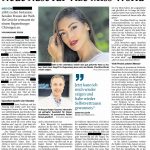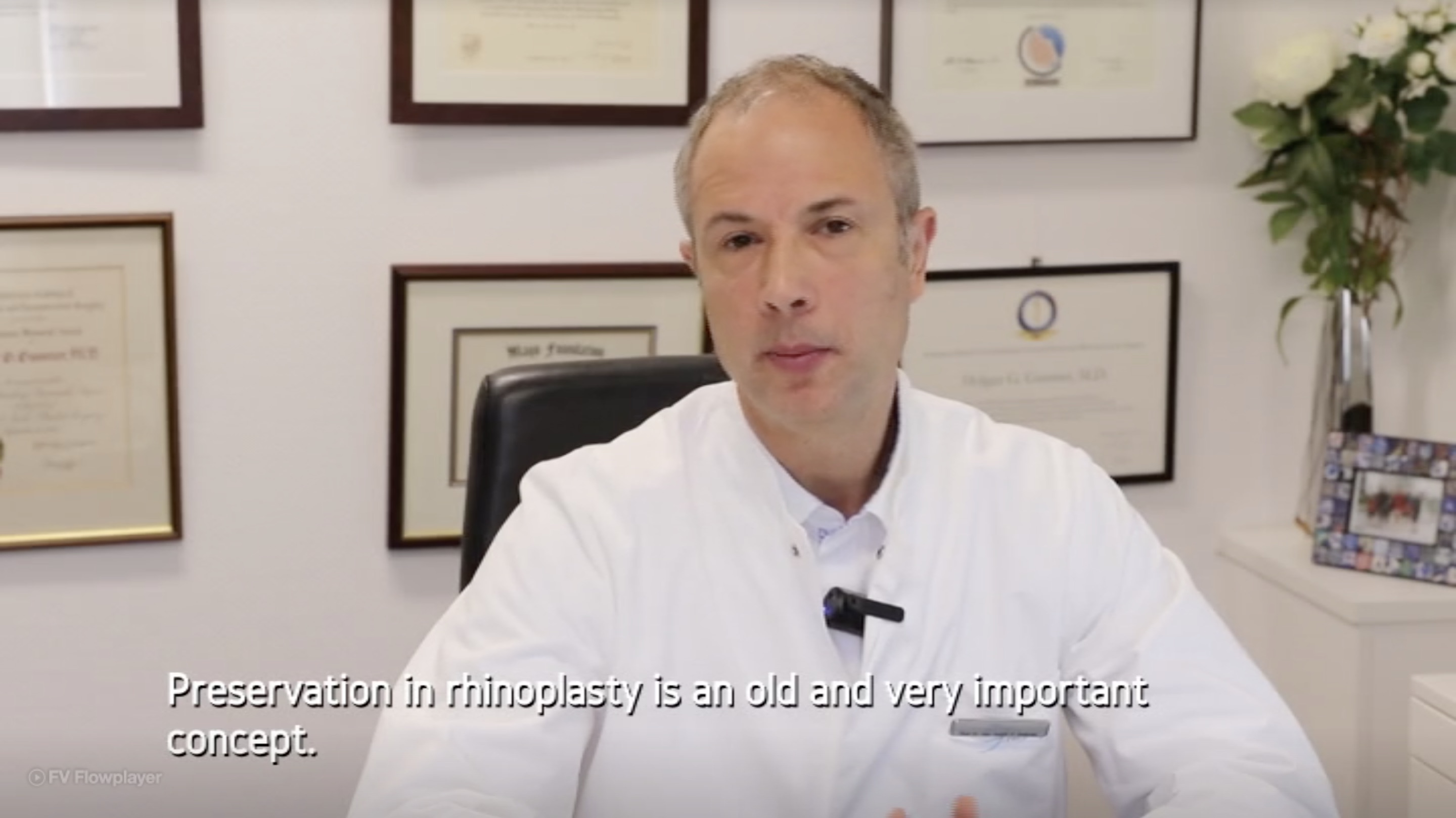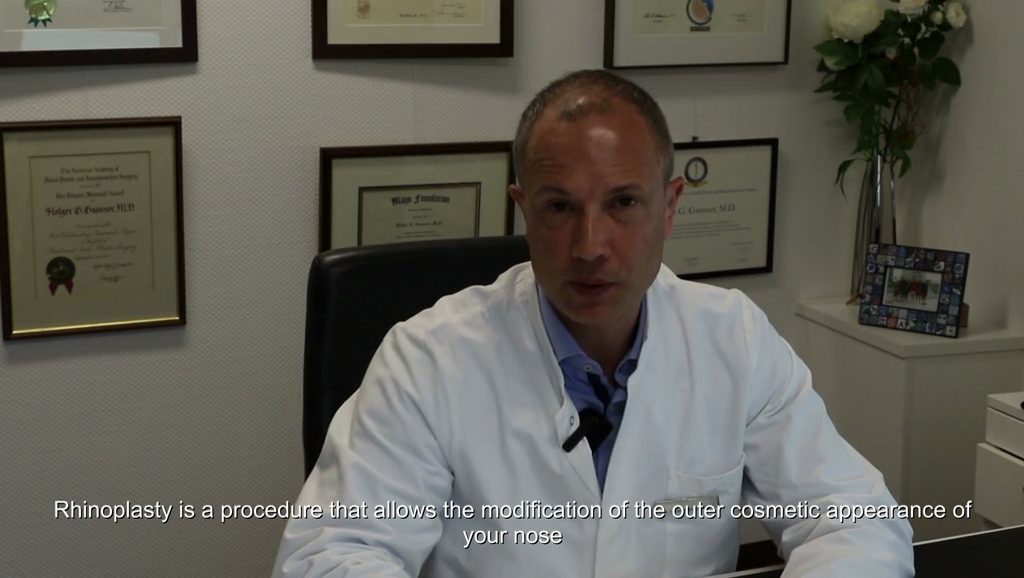
Dr. Gassner is your globally recognized expert in cosmetic and functional rhinoplasty. He is a regular speaker on the subject at international congresses, including the world-renowned “Advances in Rhinoplasty”, “AAFPS Conference” and IFFPSS Conference”. Dr. Gassner routinely performs demonstrations of rhinoplasty operations to international audiences at surgical congresses. As Director of the congress, “The European Course in Endonasal Rhinoplasty”, he directs one of the largest European conferences in facial plastic surgery, with a faculty and guest speakers of world-renowned recognition. Professor Gassner has written widely referenced publications and book chapters on the topic of nasal surgery. He performs between 4 and 6 rhinoplasties per week and has so far completed over 3000 rhinoplasty surgeries. Approximately two-thirds of these operations are primary operations and one-third revision surgeries. Dr. Gassner receives referrals for primary surgery, revision surgery and second opinions on a regular basis from regional and international colleagues. His patients include prominent figures from the media, fashion, and professional sports. On Germany’s most significant patient evaluation portal “Jameda”, Dr. Gassner is listed Germany´s No. 1 for the search term “Nasenoperation” (nose surgery). Professor Gassner has revised Miss Universe after two previous externally performed rhinoplasties with career – limiting deformities. The model is now back on the global stage with great success.
Click to view article in English
N N is one of the most beautiful women of the world. She trusted her face to a Regensburg surgeon.
BY MARIANNE SPERB.
N N is one of the most beautiful women in the world. After two unsuccessful operations of her nose, she hardly dared to be among people anymore. She sought help from a surgeon in Regensburg. “I was bitter,” says N N. “I couldn’t get any invites or accept offers for shootings. I no longer dared to post pictures to my social media accounts.” For the 30-year-old, looking good is an essential aspect part of their job. She is a star in Europe and present in the media, as an actress, as the cover on magazines like “Cosmopolitan”, as a face for cosmetics companies and as an influencer. What N N looks like and what she wears, sets trends. 2004 she became the most beautiful woman in Hungary and in the same year she just barely missed the title of Miss World in London. The 1.73 meter tall beauty came in second.
Operation lasted four hours
N N had problems breathing through her nose and wanted the looks of her nose corrected. A first intervention was unsatisfactory, the result of a second surgery rather worse than better. “A happy coincidence brought me in contact with Professor Holger Gassner. I will be grateful to him for the rest of my life.” she says. “Now I am happy to show myself again and have regained my self-confidence.” “The surgery was difficult,” says Professor Holger Gassner. For four hours he operated. For the reconstruction he also took cartilage from behind the ear. “If he wasn’t so much with his heart and soul in his profession, I certainly couldn’t be so positive today to tell about the operation,” says das model.
It became evident only during the procedure how extensive the tissue changes were. N N thought it was unthinkable to have a beautiful nose again. No body part is more prominent placed as the nose. A millimeter decides on the aesthetics. There are no standardized proportions how a beautiful nose should look. It is in the mind and hands of the surgeon. Holger Gassner has operated around 2000 noses and is in high demand as a speakers at international congresses, where he talks about his innovative, minimally – invasive endonasal techniques.
“I’m overwhelmed,” says N N about her new look. ,, Now I can show myself again and have regained my self – esteem.” I held it for unthinkable that such a beautiful result could still be achieved.” People talk about cosmetic surgery as rarely as about their income. N N, however, openly answers all questions. Why? Out of gratitude, says the 30- year old. She’s not only a celebrity, but shows herself to be approachable, allows her followers to participate in her life, also reveals her concerns. The new nose plays an important role for myself, and as a mother of a little boy and a little one girl. “I wished that they have a mom who is balanced and is happy. As long as the deformity of my nose overshadowed my life, I couldn’t give them everything they deserve.”
“A lot of people say looks are not that important. To myself it is important. I am very critical with myself and a perfectionist. Having these two qualities is not ideal,” says N N, “but I have to live with them.”
Performing surgery in the face of a Miss World is a challenging task. Was Professor Holger Gassner nervous before the OP? “The tension was no different than usual,” he says. “For every single patient, the appearance and function of the nose is of paramount importance. You invariably give your very best, regardless who your patient is. The surgeon is used to prominent patients from the fashion business, media, and athletes. As our paper found out, just recently a prominent female flew in her private Lear jet for treatment. Asked about the role of VIPs in his practice, the professor says only: ,,Attention and responsibility is equal “, with a billionaire being no different than a woman who saves the money for a correction, because they see sees herself differently than what the mirror shows.
The professor is a philanthropist. He received his surgical training together with Professor Kofi Boahene at the famous Mayo Clinic in Rochester. During their training, the two friends shared a vision: To build a specialized hospital to take care of patients with facial deformities in Ghana: The 2.2 million Euro pro bono project is financed through donations. One milestone has been achieved by the two top surgeons from Regensburg and Johns Hopkins Medical Center: The ground is broken, construction has begun and for now, around 700,000 Euros have been collected. These include donations from patients, as well as proceeds from charity events. But 1.5 million euros are still missing. Gallery Lesmeister will host a charity for the two doctors at the end of August. The title of the exhibition in the Bachgasse could not fit better: “Belle toujours?!”
Computer Simulation before Nasal Surgery with morphing software allows Dr. Gassner to simulate your possible result after rhinoplasty (nasal surgery). This method is particularly suitable to show possible changes in the view from the side (profile). For example, the removal of a nasal hump, the augmentation of a nasal saddle, the elevation of a droopy nasal tip or the reduction in size of a nose that is too large can be shown before surgery.
Computer simulation allows Dr. Gassner to create realistic expectations about the result that can be achieved for you. Of course, one must stress that the actual result after surgery may differ within certain tolerances from the simulated image. Dr. Gassner will explain to you in detail the opportunities and limitations of this method. Of course, the simulation cannot be regarded as a guarantee for a surgical result.
This method is suitable to show changes from the side view and often also in the fornt view. Very complex deviations such as the cleft nose deformity or complex asymmetries may not always be well simulated.
Please, feel free to contact us through the link contact if you would like to arrange for a Skype consultation with computer simulation of your nose by Dr. Gassner.
The public display of before and after photographs of cosmetic procedures is illegal in Germany. Therefore, only results of reconstructive rhinoplasty are shown in our gallery. During your personal consultation, Dr. Gassner will show you a large number of results of purely cosmetic rhinoplasties.
Dr. Gassner makes special efforts to employ surgical techniques that are as non-traumatic and minimally invasive as possible. Nasal packs are designed to plug the nose and to minimize the risk of any nosebleed after surgery. These packs may be perceived as unpleasant as they fill up the nose and typically do not allow for nasal breathing.
Dr. Gassner utilizes special surgical techniques that allow to avoid nasal packing in virtually all cases. Further efforts to minimize trauma to the soft tissues of the nose include the use of the endonasal approach, the use of Piezo technology and controlled hypotension anaesthesia. Our patients are usually inconspicuous to the public and able to return to work after 8 to 12 days. The probability of the need for nasal packing after a nasal surgery by Prof. Gassner is less than 1%.
As with a first operation, there are basically two different techniques for post-correction: In the so-called open technique, the skin is cut through the nasal bridge by a scalpal incision. The skin soft – coat is then lifted off the nasal tip and the nose is “opened”. Advocates of this technique suggest that the overview is better and that more complex changes can be corrected more easily. The disadvantages of the open technique can be a somewhat broader scarring, the need for more elaborate cartilage transplantation, the consumption of more septum cartilage and possibly the formation of somewhat harder nasal tips.
In the closed technique all cuts are performed inside the nose. The advocates of the closed technique suggest that the method is more gentle because the tissue dissection is less broad. The skin cut with the scarcely visible scar at the incision site is avoided. One generally needs less graft material, which naturally better maintians the soft texture of the nose. The disadvantages include, for the surgeon, less overall visability. The technique is more difficult to learn and can also be a little longer regarding operating time.
Professor Gassner personally prefers the closed technique for various reasons. He is particularly concerned about gentle treatment of the tissues. For difficult and complex operations, e.g. Revisions and corrections of gap noses, the closed technique allows an approach in the less scarred tissue, which allows less trauma to occur. Professor Gassner agrees with the vast majority of international experts that the choice of access is not essential.
Most experts agree that excellent results can be achieved with both approaches. The skill and experience of the operator are much more important factors for the expected outcome than the choice of access. A higher complication rate or less successful prospects could never be attributed to one or the other access in a study. Therefore, statements that the one or the other approach is in principle superior or disadvantageous would be considered as not serious.
The correction of the nasal tip requires especially delicate and gentle operational techniques. Many devaitions in the shape of the nasal tip can be corrected. These include a pug nose, a broad or drooping nasal tip, or an asymmetrical nasal tip. Both the open as well as the closed approach of rhinoplasty allow for corrections of the nasal tip.
In the majority of cases, Professor Gassner performs corrections of the nasal tip using the closed appraoch. Hierfür hat er einen eigenen Zugangsweg entwickelt, der auch in anderen Zentren Anwendung findet: “The endonasal complete release approach”. This technique not only avoids scarring of the columella, but also has the goal of avoiding an unnaturally hard nasal tip and reducing the amount of cartilage taken from the nasal septum.
Swelling of the area around the nasal tip can occasionally persist a bit longer. Typically, a patient can be out in public about 10 days after nose surgery without attracting unwanted attention. The swelling slowly decreases over the following weeks and months. During the healing process, the swelling in the bridge of the nose diminishes more immediately than that of the tip. For this reason, the nasal tip can seem a bit larger in comparison to the bridge after about 8 to 12 weeks. The swelling is mostly gone after around 6 months, and is completely gone after 1 year following surgery.
Professor Gassner is a recognized expert regarding the endonasal (closed) approach to the surgical correction of the nasal tip. Accordingly, he co-authored the corresponding chapter in the most crucial English-language textbook for facial plastic surgery along with Professor Nolst Trenité (see below). In addition, he has published a variety of significant scholarly articles concerning this topic, and is regularly invited to operational courses to perform these techniques, as well as to international congresses to lecture on them.
Nolst Trenité G., Gassner HG. Endonasal rhinoplasty. In: Facial plastic and reconstructive surgery, Ira D. Papel (Ed.), 4th edition, 2016
The piezotom technology allows for very gentle remodeling of the nasal bones. In contrast to mechanical instruments like chisels, the ultrasonic device cuts and shaves bone through invisible high frequency vibrations. The instrument is placed with a cutting or shaving tip on the bone and smoothes its way through the skeletal structures. One key advantage of the instrument is that it does not injure soft tissues. Thus, bleeding and bruising can be further reduced.
Dr. Gassner uses the Piezotome to reduce the bone of a nasal hump, to straighten a deviated nose and to adjust bones on the inside of your nose for better breathing. The piezotome represents one of multiple measures Dr. Gassner employs to provide to softest possible surgery for your quick recovery. It allows to perform the vast majority of cases in the ambulatory setting, many under local anaesthesia with sedation.
Professor Gassner’s highest priority is to utilize gentle operational techniques in the treatment of nasal obstructions. These treatments are often performed in conjunction with cosmetic operations. A precise diagnosis regarding nasal obstruction is of the utmost importance. Three factors often play an important role in determining a nasal obstruction.
A deviation of the nasal septum is often connected to a nasal obstruction. In such cases, it is important to remember that even a typical, healthy septum is not perfectly straight. It is thus crucial to carefully analyze which areas of the nasal septum obstruct the airflow of the nose.
The nasal conchae, or turbinates, can also contribute to a nasal obstruction. The nasal conchae are oblong structures on the inner lateral wall of the nose, and they fulfil an important task: they warm and humidify the air one breathes. This function can be restricted, for example in women who have experienced the changes of menopause. The resulting dryness can, in many cases, detract from a patient’s quality of life. It is Professor Gassner’s goal to keep the functional tissue of the nasal conchae fully intact. He simply removes sections of the bone located inside the nasal conchae, which reduces their diameter, and causes them to conform to the shape of the inner wall of the nose. This opens up more room for air to flow past. The sections of the nasal conchae that warm and humidify the breath – mucous membrane and the underlying soft tissue – are left completely alone.
Another important cause of nasal obstruction is the so-called nasal vestibular stenosis. (Die Nasenklappe wird durch das Weichteilgewebe des Nasenflügels gebildet, etwa einen halben Zentimeter oberhalb des seitlichen Nasenflügelrandes). The soft tissue in this area can be pulled into the nasal airway and cause an obstruction. This cause of nasal obstruction must be diagnosed with the utmost care, and the correction integrated with a rhinoplasty. Professor Gassner performs a correction of the nasal wing (Nasenklappe) during most rhinoplasties.
Professor Gassner is regarded as an expert in the surgical correction of nasal obstructions. He performs many, often difficult revision surgeries, for example following accidents, previous operations, and also congenital malformations. He authored the corresponding chapter in the most relevant English-language text book for facial plastic surgery (see below). For the correction of the Nasenklappe, he was the first to describe the “Stairstep Graft”. He is regularly invited to demonstrate his techniques at surgical courses, and to lecture on this subject at international congresses.
Gassner HG, Sherris DA, Friedman O. Rhinology for the Facial Plastic Surgeon. In: Facial plastic and reconstructive surgery, Ira D. Papel (Ed.), 4th edition, 2016
Nowadays, children that are born with a cleft palate can typically be successfully treated with a handful of surgical steps within their first few years of life. The main objective during this process is the restoration of such functions as speech and swallowing, as well as the closure of the cleft lip. During the years of adolescence, the appearance of the nose becomes increasingly more important. Professor Gassner typically performs the correction of a nose deformity due to a cleft lip after the age of 17.
The development of a cleft palate has a large impact on the development of the nose. Typically, this causes a constriction of the nostril on the side of the cleft, and a deflection of the septum on the other. Other distortions include the flattening and deflection of the nasal tip, as well as a change in the shape of the base of the nose. A correction of these distortions should occur after the growth spurts of puberty, in order to avoid further malformations due to growth disturbances.
The operation of a cleft palate is seen as quite difficult. This is due to the correction of asymmetry of the soft tissue representing a great challenge. The construction of the cartilaginous framework demands special measures. Removal of some rib cartilage is often necessary. The removal of this cartilage occurs via a small incision, which, when performed on women, is done under the fold of the breast in order to remain inconspicuous.
Particularly complex distortions can require an approach involving two separate surgical steps. The treatment is specifically adapted for each unique distortion, and Professor Gassner will walk you through the treatment in one or more detailed consultations. Professor Gassner often corrects the scarring of the lip during the same operation. In most cases, Professor Gassner avoids an open approach involving an incision on the bridge of the nose. The usage of nasal packing is usually not needed, and the cast only lasts about 10 days. After about 10-14 days, patients are normally able to publically present themselves as usual.
Professor Gassner is a trusted expert when it comes to the surgical correction of a cleft palate. He has developed a surgical technique through which the asymmetry of the base of the nose can effectively be corrected. Professor Gassner lectures internationally on this technique, the “Foundation Graft”. This technique was published in the professional journal, “Facial Plastic Surgery”. Professor Gassner receives patients for cleft palates from all over the world.
As a passionate athlete himself, Professor Gassner can completely understand the needs of physically active patients. Professional athletes represent a special set of requirements. Frequently, the intent is to resume training as early as possible. The risk of physical contact to the nose, unfortunately, cannot always be eliminated for months after surgery.
Impaired nasal breathing can have a negative effect on overall performance. This is especially the case with regard to endurance sports. Some medications prescribed to improve nasal breathing (e.g., phenylephrine) in many countries are on the doping list. Also, the drug treatment of nasal breathing can be more likely to reach its limits in professional athlets than in patients with an average level of physical activity.
Preservation of the physiological mucous membrane function of the nose appears to be of particular importance for endurance athletes. Humidification and heating function of the nasal mucosa is particularly stressed with high volume airflow. Professor Gassner is particularly concerned to take account of these aspects in the medical and surgical treatment of nasal airway obstruction in people with high physical activity levels.
If the external shape of the nose further contributes to nasal obstruction in professional athletes, this introduces additional important aspects for consideration. The nose may be deviated as a result of sports accidents or other trauma causing the nasal airways to become narrowed and/or obstructed. A surgical procedure to correct the external shape of the nose may necessitate careful cuts in the nasal bones. During the healing phase, the stability of the nasal skeleton is temporarily reduced. The risk of reinjuring the nasal skeleton during the early healing phase must be carefully balanced against the benefits of being able to resume training in competition earler. This certainly requires very extensive and diligent preoperative discussion. In some cases, the surgeon and the patient may decide to have a protective facial mask manufactured so that training and competition could possibly resume at an earlier point in time.
Particularly within the martial arts and full contact sports such as boxing or judo, Professor Gassner recommends that any change to the external form of the nose wait until the end of the athletic career. The risk of repeated damage to the structure is too high. Professor Gassner has prominent athletes as patients, including professional soccer players, former boxers, endurance athletes and tennis players.
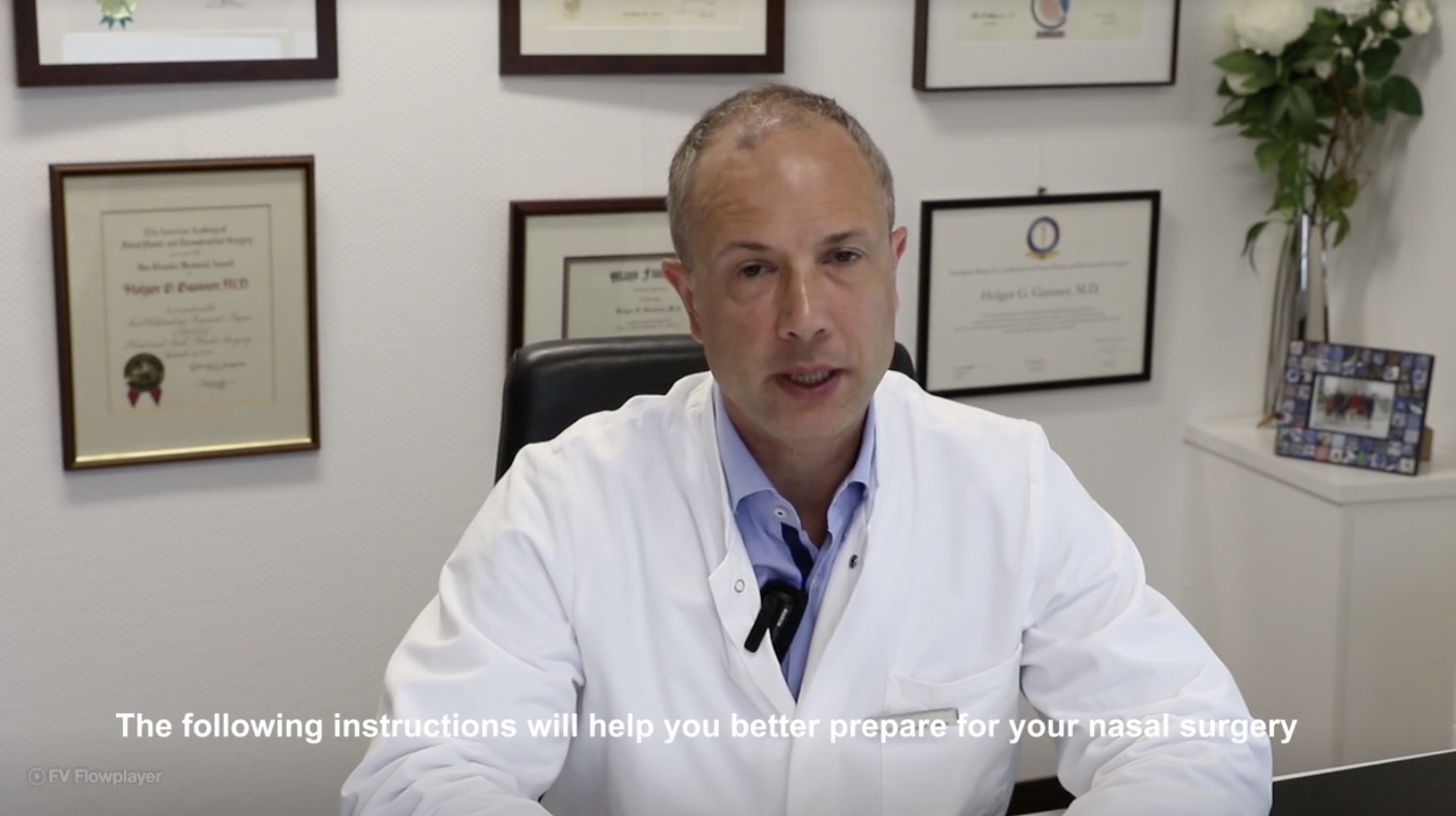
Frequently asked questions before a nose surgery include: What can I contribute to the success of my nose surgery?, Are there things I need to consider, things to avoid?
You can make an important contribution to the success of your nasal surgery. The following instructions only apply to patients who are operated by Dr. Gassner. Please note that this information should only be followed after prior consultation with Dr. Gassner.
Three weeks before surgery, certain medications and other substances should be avoided as they can influence the blood and the body’s ability to regulate blood flow; they can cause the blood to become too thin and not clot as quickly as usual. These include painkillers such as: Aspirin®, Ibuprofen®, Diclofenac®, and Voltarol®. Gingko, garlic and vitamin preparations are also included.
Wearing glasses (reading or others) should be avoided for up to 6 weeks after a nose surgery. The use of prescription contact lenses is recommended for this time period. Alternatively, light frames may be held to the forehead with tape; any pressure on the nasal bridge during the healing process should be avoided.
When the nasal mucosa is in good condition, conditions for the operation are optimized. Application of a greasy skin cream or ointment to the inside of the nasal passages once daily for about one week before the operation helps to maintain and positively support the mucous membranes.
Exposure to the sun and tanning beds (Solariums) can cause inflammation and swelling of the skin. Therefore, these should be avoided beginning 10 days before the surgical date.
Nicotine reduces blood flow to the tissues and can delay wound healing. Therefore, consumption of cigarettes should be minimized or avoided beginning at least one week before until at least two weeks after surgery.
On the evening before the operation, all traces of make-up should be gently removed. If possible, carefully trim nose hair using a small scissors with round tips so as to avoid accidental injury. Gentlemen are kindly requested to shave the moustache portion of their beards.
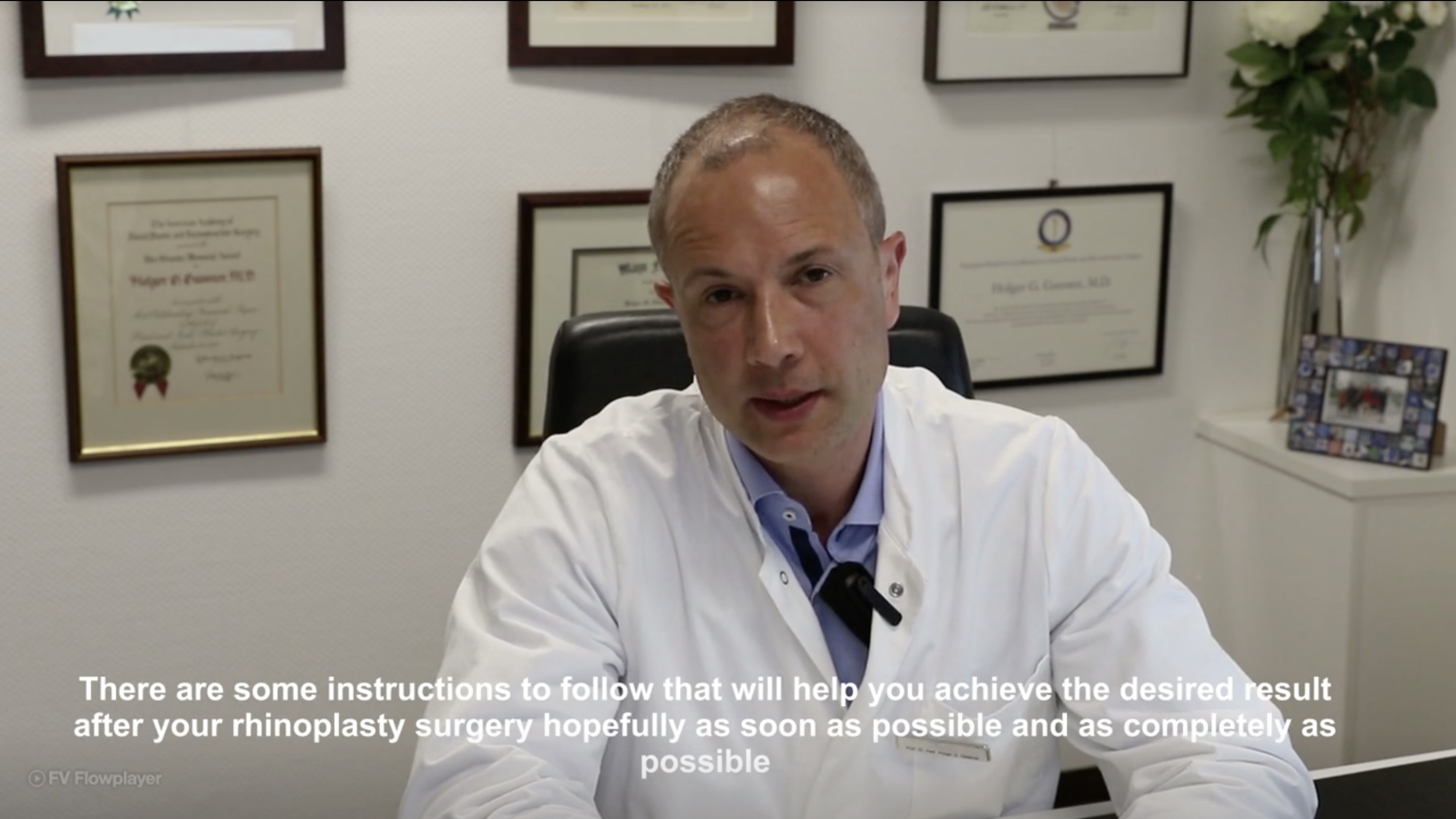
Frequently asked questions about nasal surgery are: How long do I have to wait before I can play sports? When can I wear glasses again? May I sunbathe, use the Solarium (tanning beds), have a sauna? Do stitches or packing need to be removed?
You can make an important contribution to the success of your nasal surgery by following the recommendations that Dr. Gassner gives you during your detailed consultation. Nasal correction surgery is adapted individually and carried out differently patient to patient, which often means the post operative treatment are also adapted to the individual. The following instructions can only apply to patients operated by Dr. Gassner; these recommendations may only be followed after prior consultation with Dr. Gassner.
What is important to know in the first days after nasal surgery?
During the first two days after the surgery, compresses soaked in ice water should be placed over your cheek and eye area. Elevating your head and upper body with pillows helps further to reduce swelling and bruising. Usually, you are able to get up and walk around soon after the surgery. You should still stay relaxed and avoid all activity that would increase your blood pressure.
Professor Gassner places much effort on gentle surgical technique in order to reduce edema. He places no nasal packing. As a consequence, you may be able to beathe through your nose as soon as the first night after surgery. During the first night, you may experience some light secretions or bleeding coming from your nose. This may be dabbed with a compress. Tolerating these secretaions is much more pleasant for the patient than having the nasal packing placed.
Usually, with assistance, you may wash your hair the first day after surgery. Your nasal cast should not get wet. As long as you are wearing the nasal cast, you may wish to prefer clothing with a wide collar in order to avoid touching the nasal cast while getting dressed. Decongesting nasal sprays may be used as directed until the cast is removed. You will receive a nourishing nasal lotion for you to use as directed.
The nasal cast is usually removed after 7 days with a special solution to dissolve the adhesive. Your nose will still be swollen to some degree externally and internally. This swelling will decrease markedly over the following 1 – 2 weeks. Often, you are inconspicuous to the public after about 7 – 14 days after surgery. Some edema of the nose persists for a while. You will notice that the swelling will be more pronounced in the morning and will decline during the day. Uusally, the swelling over the nasal dorsum will ebb away more quickly than over the nasal tip. Swelling may persist significantly longer in revisional surgery.
Sometimes the skin of your nasal bridge is still somewhat sticky after removal of the cast. It is okay to wash your nose after the removal of the cast, however, please be gentle; wash with lukewarm water, mild soap and carefully dab the area with a soft towel.
The nose is still soft and malleable in the first 3-4 weeks after surgery. This window of time is sometimes used to correct complex deformities when the final shape of the nose is carefully optimized through exercises. These exercises should, of course, only be carried out according to detailed instructions from Professor Gassner. Blowing the nose and pressing the nose together should be avoided for at least 4 weeks after surgery. Sneezing is rarely a problem during the recovery phase, even with allergy sufferers. If you need to sneeze, do so with your mouth open.
Do bandages or stitches need to be removed after surgery?
As a rule, Prof. Gassner only uses dissolvable sutures. In the overwhelming majority of nasal operations, no suture of the outer skin is necessary. The threads are inside the nose and disappear by themselves in the first 2 – 6 weeks. Two weeks after the operation, sutures that interfere or itch in some way may be carefully cut off with a nail scissor by the patient. Nasal packing is, generally speaking, not used post surgery.
When can I wear glasses again?
Wearing glasses can affect the cosmetic results of a nasal correction. In order to minimize this risk, it is advisable to wear glasses, at the earliest, 6 weeks after surgery. If possible, the use of contact lenses is recommending during the first 4-12 weeks after surgery. Depending upon the individual, this plan can be adapted; Professor Gassner can give you precise recommendations during the consultation.
When can use the sauna, tanning beds, or be in sunlight after a nose operation?
Intense sunlight, sauna and tanning beds (Solarium) can increase swelling and should be avoided until 3 months after a rhinoplasty. A high SPF sunscreen (at least 30 SPF) should be applied regularly when one will be outdoors in the first 6 months after the operation. In addition, a sun hat should be worn in intense sunlight.
How long until the swelling goes away?
After a nasal operation, swelling will occur. The intensity and extent of the swelling varies from individual to individual and is dependent upon a number of factors. Factors include: surgical technique used, the patients’ predisposition, and the extent of the necessary changes. In postoperative procedures, swelling usually remains longer than after initial operations.
Prof. Gassner pays particular interest to decreasing swelling using careful surgical techniques. The overwhelming majority of his patients are up and about in public at the time of the removal of the nasal splint, approximately 10-12 days after surgery. The remaining swelling decreases slowly and has generally decreased to 85% reduction after 3 months. Swelling of the nasal tip can sometimes be less rapid than swelling of the nasal bridge. The impression that the nasal tip feels firmer or unfamiliar can last for up to 12 months, but this usually diminishes completely with time with first operations.
After a rhinoplasty, how soon after can I play sports?
The nose is still sensitive the first couple of weeks after a rhinoplasty. Stressful activities where the blood pressure rises may lead to an increase in swelling present, or an onset of swelling not previously seen, therefore, it is advisable to abstain from sports for a short time. Careful sport activity, such as cycling can resume between 2 and 3 weeks after surgery and the intensity of the sport gradually increased. Sports that involve intense breathing and maximum functioning of the airways should be avoided for at least 12 weeks after surgery. Sports, where there is risk of impact to the nose (soccer, handball, football, school sports) should be avoided for at least 6 months. Please speak with Dr. Gassner with regards to the specifics of your situation.
When can I blow my nose after a rhinoplasty?
The fine cartilages of the nasal tip are generally held in position by sutures until they are properly healed. To prevent these structures from shifting, you should avoid compressing the nasal wings up to at least 4 weeks after nasal surgery. If the nose is clogged, rinse with lukewarm salt water ( 1 teaspoon or 4,5 gram mixed with a half liter of water). After rinsing, a moisturizing balm should be applied to the nose, e.g. nasal ointment or oil.
It has been noted that patients do not usually have to sneeze during the recovery period after an opearation even during hay fever season. If it does happen, however, Professor Gassner recommends sneezing through the open mouth. As a rule, there is no damage that would be caused by sneezing.
Do I need a new passport or to renew other identification after a nose operation?
Modern passports and ID cards require so-called biometric photographs. These photos can be recognized by computers with facial recognition software and compared to the actual face. For example, this happens when you enter the USA and can sometimes lead to problems as the software could recognize differences between the pre-operation photo in the passport or ID and the face with the operated nose. Unfortunately, this could result in being denied entry. It is therefore recommended to apply for a new passport after a nose operation. The photo should be made 3 months after nasal surgery at the earliest.
Professor Gassner places great importance on your individual care and treatment. As a rule, several follow-up examinations are necessary after the operation at the following intervals: after 10 days to test the cast, after 3 months, after 1 year and after 2 years and if necessary, after 5 years. You will receive your before-after pictures on request after one year.
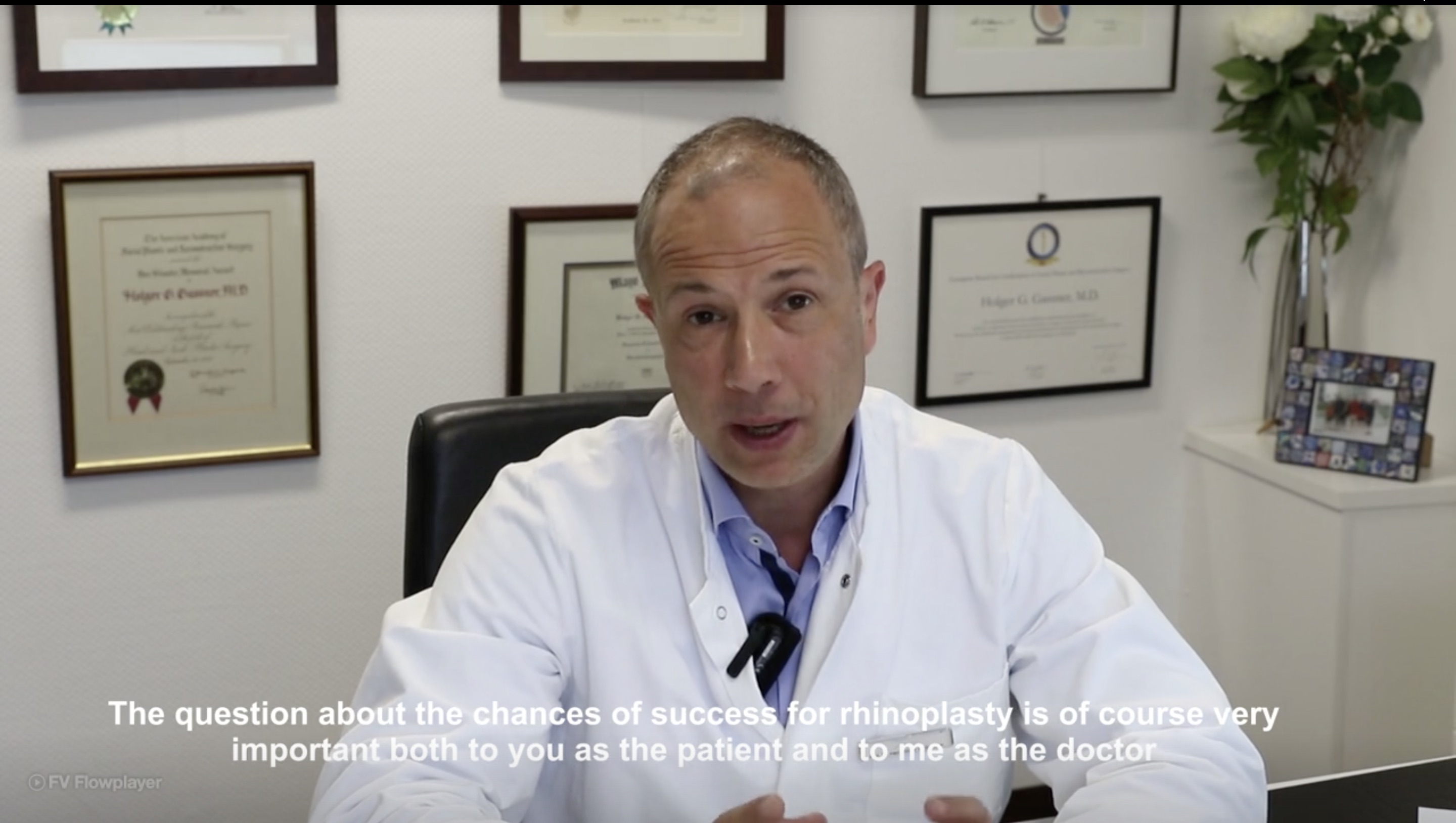
The success of a nose operation involves a few different parameters. For Professor Gassner, your satisfaction with both the external form and the quality of the nasal airways is the most important criterion. A nose cannot arbitrarily be changed. It is therefore of particular importance to discuss with you during a detailed consultation which changes in the given anatomy are possible and realistic. If your expectations are not in alignment with a realistic result, do not undergo the operation.
The requirement for a second intervention can only be used as a relative measure of a quality result. Some surgeons of note report a slightly higher rate of revision surgery due to the fact that they often offer a relatively circumscribed post-correction for minor deficits. The described frequency of such post-operations is about 5-10% in the international literature.
Professor Gassner’s frequency of post-corrections also ranges between 5% – 10%. Approximately half of the post-corrections can be performed under local anesthesia as they are minor. Generally speaking, a time period of one year should be observed before a corrective post-operation is carried out as the tissues should be given time to fully heal.
Professor Gassner attaches great importance to ensuring you are ultimately satisfied with the procedural result. In relation to the relatively large number of rhinoplasties performed by Professor Gassner every year, there are, of course, a certain number of patients who wish to undergo revision and a very small number of patients (less than one per year) who desire a second revision. Professor Gassner is particularly keen to accompany patients through the process until a satisfactory result has been obtained.
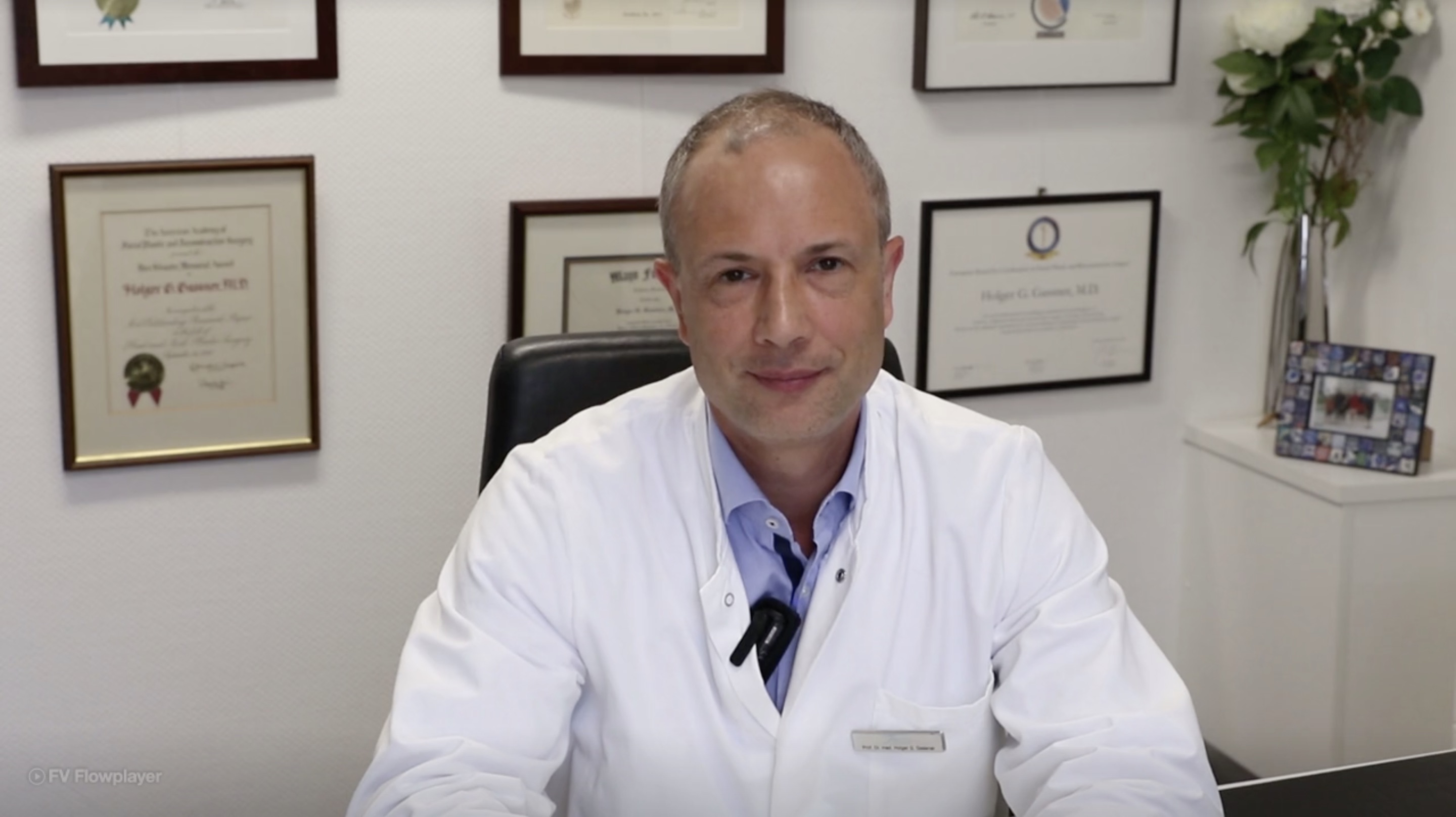
Dr. Gassner is your globally recognized expert in cosmetic and functional endonasal rhinoplasty. He is a regular speaker on the subject at international congresses, including the world-renowned “Advances in Rhinoplasty”, “AAFPS Conference” and IIFPSS Conference”. Dr. Gassner routinely performs demonstrations of rhinoplasty operations at surgical congresses. As Director of Regensburg’s course, “The European Course in Endonasal Rhinoplasty,” he organizes one of the largest European conferences in facial plastic surgery, with a faculty and guest speakers of world-renowned recognition. Professor Gassner has written widely referenced publications and book chapters on the topic of nasal surgery. He performs between 4 and 6 rhinoplasties per week and has so far completed over 3000 rhinoplasty surgeries. Approximately two-thirds of these operations are primary operations and one-third revision surgeries. Dr. Gassner receives referrals for primary surgery, revision surgery and second opinions on a regular basis from regional and international colleagues. His patients include prominent figures from the media, fashion, and professional sports. On Germany’s most significant patient evaluation portal “Jameda”, Dr. Gassner is listed Germany´s No. 1 for the search term “Nasenoperation” (nose surgery). Dr. Gassner has successfully revised the nose of Miss Universe after two previous, externally performed nasal surgery with career limiting outcome.
Corrections of the internal nose to improve nasal breathing are usually covered by a patient’s health insurance. These include a straightening of the nasal septum, a correction of the nasal conchae, and an extension of the nasal inlet (the so-called nasal valves). These so-called functional corrections usually do not result in a change in the outer shape of the nose. A cosmetic change of shape of the outer nose is always subject to “turnover” tax, according to current law. As a rule, insurance companies do not reimburse costs associated with cosmetic correction that are subject to VAT.
The cost of functional corrections of the inner nose (self-payer) are shape-modifying corrections of the outer nose depend on the necessary expenditure of the respective intervention. This is oriented to many different aspects, for example, whether it is a first or second operation, whether ear or rib cartilage transplants are necessary and how complex the changes to be corrected can be estimated.
The price of nasal surgery is an important decision criterion for many patients. It goes without saying that safety standards as well as the experience and expertise of the surgeons should satisfy the ost stringent requirements in order to obtain teh best possible, operationally satisfactory and lasting result for this investment. Many experts agree that low-priced and particularly high prices should be examined with particular care. A “co-correction” of a change in the form of a functional correction covered by health insurance is not permissible for legal reasons; it would be considered tax evasion, since the shape-changing corrections are subject to VAT.
Costs for a first-time (first nasal operation) functional correction of the nose for the improvement of nasal breathing (for self-payers) start at € 3000; the costs for a cosmetic or combined functional cosmetic correction of the nose start at approximately € 4000. The cost-of-sales charge, VAT, for cosmetic correction is also not reimbursed by private health insurance.
Basing a cost estimate using high-quality photographs is possible. Please take the pictures with a digital camera from a distance of about 2 meters in front of a monochrome background. The images should show the nose straight from the front, from a 45° angle and as a full profile from the side. The face should fill the photo fully, the top of the head and the chin should be visible.
Please send the photos as an e-mail attachment with inquiry to: secretary@drgassner.com Please note, however, we cannot be held liable for the data security of information and images transmitted by e-mail. If an in-person consultation is preferable, please contact us using the secretary@drgassner.com email, our Contact form, or call us at one of the preferred appointment locations.
The exact cost of a nasal correction can ultimately only be definitively assessed after an in-depth assessment and consultation. Thank you.
Here you find information about revision surgery of the nose.



